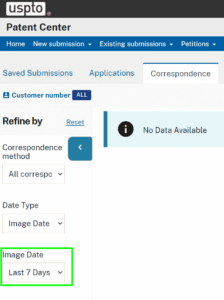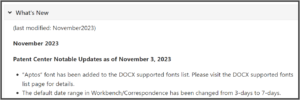
(Update: shortly after this blog post, a nice person at the USPTO got in touch.)
Today, the USPTO quietly fixed Patent Center bug CP31. For more than three years, this bug was a trap for the unwary user (blog article, June 23, 2020). The user who made the mistake of checking for outgoing correspondence using Patent Center rather than PAIR ran the risk of malpractice in two distinct ways:
-
- If the user were to check for outgoing correspondence on a Monday or a Tuesday, the Patent Center report would always state that there is no outgoing correspondence even if, in truth, there was outgoing correspondence.
- On other days of the week, on average the Patent Center report would be missing about 11% of the user’s outgoing correspondence.
Patent Center bug CP31 was first reported to the USPTO on June 23, 2020. We discussed this particular bug with the USPTO Patent Center developers during a videoconference on July 1, 2020. We discussed this particular bug again in a face-to-face meeting with the Commissioner for Patents on October 18, 2023.

Now, after foot-dragging of more than three years, the USPTO has fixed Patent Center bug CP31. See screen shot at right where the USPTO lists this as a “what’s new” item that supposedly got posted November 3, 2023. We have, of course, updated the Patent Center trouble ticket page so that bug CP31 is now listed in the “resolved issues” section and is no longer listed in the “open issues” section.
This brings the number of “open issues” down from 104 open trouble tickets to 103 open trouble tickets for Patent Center. Yes, there are still 103 reported bugs in Patent Center, forty-two of which date from the year 2022 or earlier.
The number of trouble tickets listed in the “resolved issues” section is now up to seventy-two. Yes, the USPTO’s rate of fixing bugs is 72 bugs fixed in a bit more than three years. This means the USPTO’s rate of fixing bugs has averaged about two bugs fixed per month. At this rate of progress, the 103 bugs that are still outstanding would take more than eight years to fix.
Perhaps even more discouraging is that the number of outstanding Patent Center feature requests is fifty-four, some of which date from the year 2020, and not even one of the feature requests has been implemented.
What exactly was the mistake that the USPTO developers made back in 2020, that led to Patent Center bug CP31?
One of the fundamental design goals for Patent Center, from the outset, was to bring forward all of the functions of PAIR and EFS-Web. One of the functions of PAIR has always been “display outgoing correspondence”. You click to view your outgoing correspondence that arrived today, and what shows up on the PAIR screen is … wait for it … a list of the outgoing correspondence that arrived today. This worked regardless of the day of the week on which you might do the clicking in PAIR. And the PAIR list of outgoing correspondence that arrived today included … wait for it … all of the outgoing correspondence that arrived today.
So you might imagine that this function would be brought forward into Patent Center. But what got brought forward was defective. If you happened to pick a Monday or a Tuesday to do the “outgoing correspondence” report in Patent Center, what would appear is … wait for it … a false statement that there was no outgoing correspondence that day. On the other hand, if you happened to pick some other day of the week to do the “outgoing correspondence” report in Patent Center, what would appear is … wait for it … a list of items of outgoing correspondence that on average listed only 89% of your actual outgoing correspondence that day. On average, 11% of your actual outgoing correspondence would be missing from the Patent Center report.
For three years now, the USPTO’s idea of what to do about this coding error was either of two things:
-
- Use PAIR, instead of Patent Center, to generate a report of today’s outgoing correspondence, or
- Whenever you try to use Patent Center to generate a report of today’s outgoing correspondence, use the secret knowledge that you must always remember to manually select the custom value of “Last 7 Days” instead of the default value of “Last 3 Days” in the drop-down menu for “Image Date”.
We had to get on airplanes, and fly to Virginia, and meet with USPTO Patent Center developers in person, to get the USPTO people to pay attention to this coding error. Yes, it was a single-character coding error. The Patent Center coders should have looked to see what number was used in PAIR (the number 7) but failed to do so, and more or less randomly picked the the number 3 instead.
Which, as I say, led to a trap for the unwary user. The user who chose to rely on the “outoing correspondence” report in Patent Center to identify docket dates would completely miss docket dates for any correspondence that Patent Center failed to display. And “failed to display”, on Mondays or Tuesdays, was all of the correspondence for that day. On other days of the week, “failed to display” was on average 11% of the correspondence for that day.
Again, the blog article dated June 23, 2020 that explains this coding error by the USPTO may be seen here.
Why did it take more than three years for the USPTO to fix this? Why was it that our videoconference of July 1, 2020 with the USPTO was not enough to get the USPTO to fix it?
And why, when the USPTO fixed this bug on November 5, 2023, did the USPTO not do us the courtesy of letting us know that it had finally gotten around to fixing this bug? Why did the USPTO leave it for us to find out, by stumbling upon it, that the bug had gotten fixed?
(Update: shortly after this blog post, a nice person at the USPTO got in touch.)

One Reply to “USPTO quietly fixes Patent Center bug CP31”